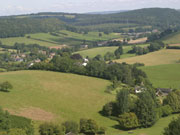 |
 |
 |
 |
As residents of Weston may know, a planning application to build 75 dwellings in the field lying north of the A40 and east of Rudhall Manor has since been reduced to 37 houses. This was partly down to local objections to the plan (including from Weston Parish Council) but the reduction was mostly achieved by – the Romans.
Part of Herefordshire's planning approval process is to assess the risk of destroying archaeology. Although the field is 700m from Ariconium, a Romano-British farmstead had previously been discovered 50 metres to the north, and the Roman road between Ariconium and the Forest of Dean passed the site's eastern boundary, so a thorough investigation of the site was launched. (Although there had been stories of Roman remains at Hunsdon Manor, an earlier dig found nothing in the Manor’s grounds.)
Archaeologists dug a number of trenches in the field and, sure enough, discovered a villa. And not just any villa. This one was important amongst the known Roman villas of Herefordshire. It was a high status dwelling, with a mosaic floor and a hypocaust for under-floor heating. The main building of the villa was in the north-eastern corner of the field with further buildings extending southward (towards the A40) along the road from Ariconium.
There were also signs of iron-smelting on the site, which might explain its prosperity and its position on the road between the iron ore in the Forest and Ariconium. As a result of these finds, Herefordshire decided that the north- eastern third of the field should be kept clear of building to protect the significant archaeology, leaving space for fewer houses. The Romans aren't history yet...
Ian Lewis
(printed in the July 2019 edition)